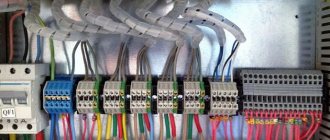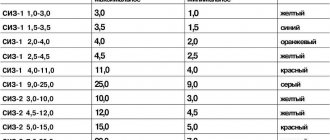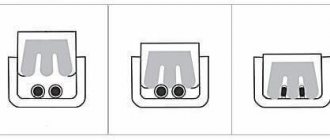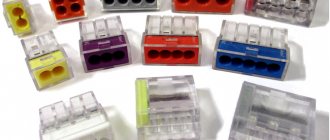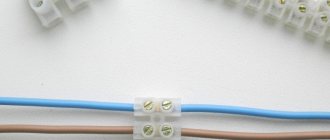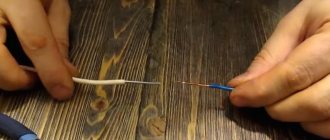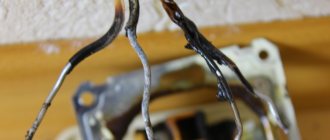When it is necessary to connect a cut cable, several methods can be used: soldering, twisting, welding or crimping. However, it is best to use terminal connections. The product is a block that has a port and is made of plastic. All elements are fixed by a printed circuit board. This is an excellent tool that will be useful in any household. Therefore, the editors of the YaNashla website have prepared for you a rating of the best terminal blocks for connecting wires for 2022.
Types of terminal blocks according to housing material
At a minimum, the supporting part is made of dielectric. Based on its characteristics, the manufacturer selects the minimum permissible distances between the terminals to prevent air breakdown.
- Ceramics. This material has a lot of advantages, and, perhaps, one drawback: it is fragile. The ceramic terminal block is used in electrical installations with intense temperature conditions: heating devices, powerful power busbars (natural heating of the conductor is allowed). In addition, ceramics are used when organizing wiring near mechanisms that have a high operating temperature. The only limitation is that there should be no vibration or shock loads in the places where ceramic terminal blocks are installed.
- Polypropylene. Durable, relatively plastic material. It resists shock loads and vibration well and does not crack when deformed. However, its temperature and dielectric characteristics do not allow use in high-voltage networks with neutral and phase wires located nearby. Therefore, polypropylene products are usually used on one line (either zero or phase), and are limited to 600 volts. Another application is terminals for connecting household lighting devices. In such blocks, zero and phase can coexist.
- Polyamide. Durable, non-flammable material with excellent characteristics. At the same time relatively expensive. Used in pads that have high performance requirements. Due to its resistance to external influences, polyamide can be used both in load-bearing elements and in the manufacture of a durable outer casing.
- Carbolite. Perhaps the best non-flammability characteristics, and the dielectric of this material is good. Withstands static loads and vibration, but may crack upon impact. Carbolite terminal blocks are used in any electrical installations, except for heating elements. Except that the cases they make are not very durable. Carbolite blocks are widely used in household lighting equipment. Almost every second chandelier is connected using such a switch.
- Polyvinyl chloride (PVC). Blocks for mass use for low-current connections. Again, household appliances and lighting. The material is non-flammable, quite durable, but deforms when heated. The main advantage is the low price. For this reason, many unscrupulous electricians use these blocks for other purposes when assembling powerful electrical installations. Such “savings” often lead to breakdowns of switchboards and electrical equipment failures. In addition, such pads are available in a convenient form factor: the line can be easily divided into the required number of contacts.
- In the manufacture of terminal blocks for wires, textolite and ebonite are also used. But these are piece products for certain projects: the material is too expensive.
The best manufacturers
Top quality products
Great company that puts quality first. The main element of the connection is brass, which is coated with a thin layer of nickel on top. This solution ensures tight contact between the wires. The insulation is made of polypropylene, which can withstand temperatures up to 100 degrees Celsius. The maximum cross-sectional area with which their products can operate is 25 mm2. Another positive point is that the terminals can be used at a voltage of 380 V and a current load of 100 A.
Legrand Terminal block blue 21x1.5-16mm2
An excellent option that is suitable for connecting most types of wires. Guarantees a person a tight connection and reliability for the entire period of operation. Sold in all specialized stores.
The average price is 470 rubles.
Legrand Terminal block blue 21x1.5-16mm2
Advantages:
- High-quality connection;
- Reliability;
- Durability.
Flaws:
Legrand blue 1x6-25+12x1.5-16mm2
A good block designed for dense connection of cores. Suitable for use at home. The case is made of high-quality plastic that does not deteriorate over time and can withstand heavy loads.
The average price is 450 rubles.
Legrand terminal block blue 1x6-25+12x1.5-16mm2
Advantages:
- Connection density;
- High-quality case;
- Price.
Flaws:
Universal terminal block 8×1.5-16 mm2, 75 mm
A good model that can be installed in many homes and businesses will guarantee a tight connection for the entire period. Can fix almost any wires.
terminal block Universal terminal block 8×1.5-16 mm2, 75 mm
Advantages:
- Good build;
- Tight connection;
- Durability.
Flaws:
Rating of the best terminals
The products of this company are among those in demand for 2022. This is made possible by tightly connecting contacts in all circumstances. In addition, even an inexperienced user can make the connection; just look at the instructions and that’s it.
The products are available in two variations: disposable and reusable, each user decides which one to choose independently. The maximum current load is 32 A, but in some options the value does not rise above 25 A, this is also worth taking into account.
The company produces products that are designed to connect single-core elements with multi-core ones, which is a big advantage. However, their cost is not much different from standard models.
WAGO 4 wires with contact paste
An excellent product that is made in a classic style and can provide reliable fastening to almost any element. The body is made of durable plastic.
The average price is 15 rubles per piece.
WAGO terminal block for 4 wires with contact paste
Advantages:
- Low price;
- Good quality;
- Tight fixation.
Flaws:
WAGO 3x(0.08-4.0)
The model is designed for quick installation. This terminal block can fix almost any wire, which is a big advantage.
terminal block WAGO 3х(0.08-4.0)
Advantages:
- High-speed installation;
- Affordable price;
- High quality case.
Flaws:
WAGO 2 221-412
A popular product that is in demand among electricians. The body is made of durable material that has a long service life.
terminal block WAGO 2 221-412
Advantages:
- Price;
- Reliability;
- Universal application.
Flaws:
Rating of quality models
The products of this company are suitable for installation at home or in a factory. The company produces screwless terminals that will provide people with quality and reliability. Using this element, it is possible to fasten cables of each type. Some models are made half open, while others come in a closed shell.
STEKKER LD294-4002
The model is suitable for fixing single-core and stranded conductors. The case is made of high-quality plastic that does not deteriorate from prolonged use. Fastening occurs quickly and efficiently.
Cost – 30 rubles.
terminal block STEKKER LD294-4002
Advantages:
- Durability;
- Fire resistance;
- Maximum current – 16 A;
- Price.
Flaws:
Screw type terminal blocks
Screw terminal blocks are one of the most common types. They are a brass sleeve with two bolts in a plastic case. Contact is ensured by bolt pressure. The body can be made of different materials - polyethylene, polyamide and polypropylene. With their help, you can connect wires with a cross-section from 0.5mm2 to 35mm2.
The advantages of screw pads include:
- No special tools required (only a screwdriver is needed).
- Reusable.
- Possibility of using the required number of segments.
Screw pads also have a number of disadvantages:
- High contact resistance.
- Low reliability (weakened by vibration).
- Restrictions on wire material.
- Installation duration.
- Requires some skill to tighten.
- Annual maintenance required.
It is not advisable to connect aluminum wires with such terminals. They have increased “fluidity”; the connection weakens over time. To avoid heating due to an increase in contact resistance, it is necessary to tighten them regularly. This creates inconvenience during operation.
Certain problems also arise with multi-core wires. With screw connections, high-quality installation can only be performed using special tips or blocks with a pressure plate. Otherwise, there is a risk of damage to the cores when tightening the screw.
Thus, single-core copper wires are most suitable for this design.
Installation with a screw connection is very simple:
- Cut off the required number of terminals from the block (with a regular knife).
- Strip the insulation of the connected wires (5-12mm).
- Insert the stripped ends of the wires into the terminals;
- Tighten the screws.
It's easy to deal with
The main thing is to be careful when tightening screws and choose quality terminal blocks
When choosing, you need to pay special attention to the manufacturer of the product. Today there are products of different brands on sale
It is better to use products from such well-known manufacturers as Legrand, ABB, Tridonic, Werit.
Product prices depend not only on technical characteristics, but also on the manufacturer:
| Manufacturer | Type | Characteristics | Price, rub |
| Tridonic | EKL 0 S | 450V,32A,12pairs,4mm2, white. | 55,64 |
| Legrand | Nybloc 034211 | 250V,24A,12pair,4mm2, black. | 209,00 |
| Korner | OK 432-PLP-BN | 450V,32A,12pairs,4mm2, white. | 118,68 |
| Tridonic | EKL 3 S | 750V,76A,12pair,16mm2, white. | 158,78 |
| Legrand | Nybloc 034211 | 250V,76A,12pairs,16mm2, white. | 540,49 |
| Werit | 112-11521 | 250V,63A,12pairs,16mm2, white. | 299,23 |
TB Series Terminal Blocks
The pads are made of hard black plastic. Already better. They have a removable lid: And this is the internal structure:
Unscrew, insert the wire, clamp.
Pros - it is not a screw that clamps, but a metal plate. Press it against the bottom steel plate. In addition, the upper part is not flat, but with a characteristic surface, which increases the clamping surface:
However, it is advisable to check aluminum ones at least occasionally for looseness of the pressure. I saw the pads themselves for currents of 25A and 40A. The inconvenience is that it cannot be cut or divided, either buy a bunch of small ones (I have never seen less than 6 pieces), or even put one large one on two wires.
Self-clamping terminals (WAGO or REXANT series 773 and their copies) Or they are also called express terminals. Here they are: Very convenient things. I stripped the wire, pushed it all the way inside, and it was done:
Inside there is a pressure plate (blue arrow) and a small bar (orange) made of tinned copper: When wires are pushed into it, this is what happens:
The plate presses the wire against the bar, maintaining pressure all the time. And the design of the pressing part does not allow the wire to fall out. It's hard to get him out. In general, they are disposable, but if you really want to, then by carefully rotating the wire around its axis you can pull it out.
Since the copper contact is tinned, you can insert an aluminum wire into such a terminal without fear of problems. At the same time, constant pressure will not allow the aluminum wire to fall out.
The white paste (in the next photo you can see the white mass on the contact) is quartz sand with technical petroleum jelly, especially for aluminum wires. Quartz sand is an abrasive that removes the oxide film from the surface of aluminum, and Vaseline prevents it from forming again.
The same terminals, but transparent:
They are no different except for the dye. Well, in transparent terminals it is more convenient to see the wire - whether it is pushed in completely or not. Plastic is non-flammable and melts when the temperature rises without releasing harmful substances into the air.
Designed for 25 A, which is approximately 4 kW. Attention! Currents are indicated for original WAGO terminals only.
WAGO 222 series terminals with levers. I have only seen the Vagov ones, they don’t produce others.
For particularly difficult cases, when there are several types of wires of different thicknesses, aluminum, copper, etc. Raise the lever:
We push the wires in, lower the lever:
If necessary, you can lift the lever, pull out the wire, and insert another one. And so many, many times. An excellent thing for those circuits whose wiring can change a lot of times.
They eat everything. Current - up to 32A. Inside there is a plate that presses against the common bus and is connected to a lever. Cunning design, in general.
The shank is tinned copper, as usual:
Scotch-lock, ScotchLok, electrical connector with mortise contact.
This is for low current (network, phones, LED lights, etc.). The meaning is simple - several wires are stuffed into such a thing:
After which it is snapped into place with pliers or any pressure tool. No, of course there is a special tool, but I don’t see the point in it - it is small pliers with flat jaws.
SCS and network installers especially love them for their simplicity, cheapness, water resistance, and the absence of the need to remove insulation.
Inside there is a hydrophobic gel that protects against corrosion, moisture, oxidation, etc. And a plate with a cutting-clamping surface: Or two plates: Here you can see what happens to the cable after termination: The knives cut through the insulation and are pressed firmly against the wire. There is also a version for two cables at once, and the plates are slightly thicker - quite suitable for lighting:
Of course, they are disposable and maintenance-free. It needs to be replaced - a piece of the cable with them is bitten off, and a new one is installed.
Rules for choosing self-clamping terminals
The main rule for a potential buyer of self-clamping terminal blocks is, perhaps, the mandatory verification of the product for authenticity. There are a lot of counterfeit goods on the commercial market, marked with the German brand - the manufacturer Wago itself warns about this.
The cost of such products is reduced, which naturally attracts the buyer. However, this kind of savings can result in troubles when operating the assembled circuits.
Meanwhile, without unnecessary warnings, it should be obvious that a counterfeit product is a significant reduction in quality. How to choose the right wire connectors without fear of getting a fake? In principle, everything is quite simple. You just need to be more careful when choosing self-clamping terminals for installation.
A branded product traditionally has the Wago logo printed in a clear font, usually on the top or side of the case. Also on the side are the main parameters - voltage and current.
This is what a branded product released under the Wago brand looks like. Counterfeit terminal blocks, as a rule, do not contain such a seal, or contain a partial one applied with low quality
The color of the insulating material of branded products is distinguished by a uniform, clear color. There is a mini connection instruction on the back/side of the terminal block.
When compared with Chinese counterfeit goods, terminal blocks, as a rule, do not have any of the above-mentioned differences. In addition, the fake is immediately distinguished by the blurred color of the insulator, often multi-colored.
Of course, the main points of choice are the purely technical parameters of self-clamping terminal blocks. In particular, the operating voltage and permissible conducted current.
If the mounted circuits are designed for operating voltages that exceed the capabilities of the terminal blocks, then the application becomes impractical and, moreover, dangerous.
You will learn about the color of the connected wires from the following article, the contents of which we recommend that you familiarize yourself with.
Types of terminal blocks by contact arrangement
The simplest block is a metal strip with a series of contact clamps. Designed to combine multiple wires with the same rating. For example, zero bus or grounding.
The main wire comes to one of the screw terminals, and the entire block acquires the necessary potential.
The feed-through type is designed for linear connection of wires. Often used for splicing different metals (copper and aluminum).
There is another type of feed-through terminal block.
The main principle is that parallel conductors are separated by a dielectric.
Barrier blocks are similar to pass-through blocks, but they provide more reliable protection against short circuits of adjacent wires. The dielectric extends beyond the contact plane and additionally protects the block from accidental short circuit (for example, a conductive element falling onto the terminals).
Where and how you can buy inexpensive terminal blocks for wires: prices, market overview
| Photo | Brand/Model | Product type | price, rub. | Peculiarities |
| DINKLE/DT126VP-03P | screw | 26÷37 | Operating current up to 8 A. Maximum wire cross-section – 2.1 mm2. | |
| TDM/SQ0510—0002 | screw | 27÷34 | For 12 contacts. Conductor cross-section – up to 4 mm square. | |
| TDM/SQ0527—0012/CR-413 | connection terminal | 35÷40 | Analogue of "Vago". The price is for a model with three slots. | |
| Schneider Electric/NSYTRV42BL | screw pass-through | 68÷85 | Rated current – 32 A. The clamps are made of copper alloy. | |
| Legrand/004803 | screw | 180÷190 | No insulation. | |
| WAGO/2273 | Compact | 21÷45 | The transparent part of the housing simplifies visual inspection of wire placement. |
Basic methods of connecting wires
Connection methods between wires and cables are selected depending on the metal used, thickness, number of cores, type of insulation and other factors. It is also necessary to take into account what the conditions of further operation will be.
Twist
The most common and simple method is twisting, which does not require any special tools. A strong and reliable connection is made with just a knife and pliers. It is enough to strip each core by at least 50 mm, clamp them with pliers, and then twist them together with rotational movements. The twist is wrapped in any direction and insulated.
Electrical tape should not be skimped on: it should be wound not only at the twisting site, but also on the wires themselves, extending 20-25 mm onto them. In addition to electrical tape, heat-shrinkable tubing can be used. Such a connection lasts a very long time, it tolerates vibration well and is most suitable for use in moving mechanisms. However, this method is not suitable for connecting copper and aluminum wires that have different structures and different cross-sections.
Soldering
Soldering is considered a more reliable method, ensuring good conductivity and safety. Tinning is done with rosin, and tin or lead is used for soldering copper wires. Aluminum wiring is soldered with zinc-based compounds with the addition of tin, aluminum or copper. The wires are pre-twisted, then rosin is first applied to this place, and then heated solder. At the end of the work, the connection is isolated. The only drawback of this method is the fragility of the soldering joints and their poor resistance to vibration and mechanical stress.
Terminal blocks
The most modern and progressive method is connection using terminal blocks. Such electrical connectors significantly facilitate and speed up wiring installation and confidently replace traditional switching methods. The main advantage is the ability to connect conductors made of dissimilar materials.
Thanks to the design of the terminals, direct contact between copper and aluminum is eliminated, as a result, the formation of corrosion, as happens with conventional twisting, is completely eliminated. Almost all connectors for electrical wires are made of brass alloy, and can be structurally spring, screw or knife. The internal cavities of some models are filled with a special gel, which provides additional anti-corrosion protection for the contacts.
Advantages and disadvantages of use
The following provisions are considered the main positive qualities of the terminals:
- Secure connection. The occurrence of a spark is practically eliminated.
- Reliability and durability during operation.
- High level of rigidity, which allows the terminals to be fixed more firmly.
- Ease of installation. This allows you to use the terminals at home and fix them yourself.
- During the installation process, you can get by with a simple screwdriver. No other tool is required.
A significant disadvantage is the size range of the connector. During installation work, it is worth considering the routing of wires and the installation of the distribution box.
Permanent connection
This installation method is performed in the same way as using a bolt and nut, but using a special tool - a riveter. The operating principle of the riveter lies in the rivet design.
It is a hollow aluminum tube with a thickening at one end. A metal rod with a head is inserted into the rivet. When the rod is pulled through the rivet, it forms a bulge at the other end of the rivet, while simultaneously expanding the tube itself somewhat.
When a certain maximum force is reached, the rod breaks off, leaving a clean, formed rivet. If you do not take into account the cost of the tool, the price of an individual rivet makes this type of installation the cheapest after twisting. There is only one drawback - such a connection is disposable and permanent.
Another option for permanent connections is obtained by using special tinned copper connecting tubes. Such tubes are produced in several diameters to suit the most common diameters of the wires being connected.
The stripped ends of the wires are inserted into the opposite ends of the tube and the latter is crimped with a special device. Together with twisting, this is the most compact type of connection of conductors.
This method can be used only if the diameter of the wires is the same and exactly matches the diameter of the tube.
About stranded wires
There is also a situation when you need to connect a single-core wire to a stranded one:
No, in general you can tin it and clamp it like a single core. But there is an easier option:
They are called NSHVI - Insulated Pin Sleeve End. The meaning is simple: We select its diameter to match the cross-section of the wire, twist it lightly so as not to frizz, put on the tip and crimp along the entire length (well, at least 3-4 times). That's it, now this wire can be clamped into any connections without fear that the wires will break off, the contact will be broken, or anything else. It is important to choose the correct tip diameter depending on the wire, otherwise the contact will be worse and the wire may slip out. They can be clamped even with a hammer and a screwdriver, or with pliers, but it is better with a special tool; fortunately, it is not very expensive - from 500 rubles to 2000. It is better, of course, not to take a Chinese nonname, but to take 30-40% more than the minimum price.
I use this one:
Combination of wire stripping: And crimping:
Borrowed from geektimes.ru/post/257592/
Existing types of terminal blocks for connecting wires
The terminal block is a mechanical clamp located in a plastic housing. The terminal, depending on the type of clamp, may have metal plates, springs for fixing the wire, or screws.
There are different types of wire connections using a terminal block.
Types of terminal blocks by type of wire clamp:
- Knife clamps;
- Screw terminals;
- Spring clamps.
The knife type of connections is very convenient. When making a connection, you do not need to strip the contacts; you just need to apply some force to firmly fix the wire in a special knife. These terminals are also called plug-in or automotive terminals. Using a screw type of connection, select suitable pads and the required cell sizes, insert the core inside and then clamp it with screws
When applying force, it is important not to break the wire. After about a year, you will need to check whether the screw in the connection has come loose and, if necessary, tighten it
And another disadvantage of this connection is that only two wires can be connected without problems. The most convenient connection option is a spring connection. When making this connection, you just need to insert a wire stripped of insulation into the terminal block. The lever located there will tighten the core and will not release it back; you can remove the core by pulling the lever back, but when you reconnect, the quality of the connection deteriorates. The characteristics of spring-type clamps limit their use to wires with a cross-section of no more than 2.5 mm2 and a current limit of up to 40A.
Features of connection to different terminal blocks
Preparation of the ends of the wires for placing them in the CC is, in principle, the same for all types of pads. However, in each case there are some peculiarities.
Correct determination of the stripping length of the wire is of great importance. For CC, the depth of the inlet hole may be different. The length of the stripped part of the wire must be such that the bare wire does not protrude beyond the terminal block body. At the same time, the tip should not be excessively short, otherwise the cage will clamp not the metal, but the insulation.
In detachable terminals, when crimping, it is important not to leave frayed strands of stranded wire. In the ZVI, excessive screw force can crush the stranded bundle, and a high-quality connection will not be obtained.
Additional Information. You need to use a crimper (pliers for crimping terminals and stripping wires of insulation). They are convenient for quickly and efficiently cleaning both single-core and multi-core wires from the polymer coating.
What are terminals?
Terminal clamps are electrical devices used to connect cables and wires. The design of the terminals includes 2 or more contacts made of conductive metal, equipped with fastenings for conductors. The terminal block housing is made of dielectric material to prevent short circuits or electric shock.
Conducting plates are made of copper or copper-based alloys. The minimum resistance is ensured by tinning, that is, coating the plate with a layer of tin or tin alloys. Varieties of terminal blocks are equipped with springs; a copper plate is in contact with the wire; the spring itself is usually made of chromium-nickel steel.
Plastic or porcelain is used as the insulating material of the housing. The material is selected taking into account resistance to deformation and high temperatures. The use of terminal blocks in installation has become widespread, and gradually soldering of wires fades into the background, giving way to terminal connections. Using terminals is more economical than soldering and is significantly more reliable. The terminals have proven their effectiveness in connecting wiring with copper and aluminum conductors, providing a high-quality connection and protecting the cable from mechanical stress during installation.
RCD connection diagram: instructions, methods, errors
What is an RCD in electrical engineering: types, principle of operation
Advantages of terminal blocks
Wago terminal blocks have an impressive number of advantages:
- They do not require any maintenance during operation.
- There is a separate terminal clamp for each of the connected wires.
- The connection does not require additional insulation.
- During operation, self-clamping terminal blocks of this type are absolutely safe, since they completely exclude the possibility of a person touching live parts.
- At the point of contact, the connection is gas-tight, which eliminates any possibility of oxidation of the exposed wires.
- To connect wires using such terminal blocks, an electrician does not need to make any additional efforts or have special knowledge and skills. Installation is quick and neat; you don’t even need to use a basic screwdriver. This is a huge advantage in cases where wiring has to be installed in hard-to-reach places and large volumes, or work in poor lighting conditions.
- The Vago connecting clamp has compact dimensions.
- If necessary, the connection can be easily redone.
- Due to the springs, Vago terminal blocks are impact-resistant and highly vibration-resistant.
- They withstand excess humidity, exposure to aggressive environments (for example, fuels and lubricants) and high temperatures (as they are made from materials of the low-flammability category).
- Since the spring terminals are adjusted to a specific core cross-section, the applied clamping force is optimal. This eliminates the possibility of thermal deformation or damage to the wires. Thus, Wago terminals provide a reliable contact connection for the entire period of operation.
- In a distribution box with such connectors, order and aesthetic appearance are always guaranteed.
- And, of course, a plus that all terminal blocks have is the ability to connect wires made of different metals (for example, copper + aluminum).
The only disadvantage is that the connectors must be located in places accessible for inspection and work at any time. But not only Vagov terminals have this drawback; it is inherent in absolutely all detachable connections.
Types of terminals
Terminal blocks
there are cells in the body
The advantages of such terminal blocks are that different materials can be connected. For example, a terminal connection of aluminum and copper or large cross-section and small. This is very convenient, because the connected aluminum and copper wires oxidize, which causes inconvenience during further operation. Connecting terminals do not allow direct contact of wires with each other. When choosing, you need to know the current that will flow through the wires; it must be less than the rated current of the terminal block. Reliability, of course, is less than with soldering, but it is very convenient, and installation time is also reduced.
According to the design of the connection of wires with a terminal block, there are the following types:
- screw;
- spring;
- knife
Screw terminal blocks
Installing the terminal block does not cause any trouble even for people who are far from electricians. Connecting the wires is very easy: you need to select a block with the required mesh size, insert the wires inside and tighten them with screws. You need to tighten it with a fairly strong force. You need to feel the moment when the screw is already tightened so as not to damage the core. After about a year, it is necessary to check the connection and tighten the screw if necessary. This refers to the disadvantages. There is also no way to connect three wires.
You can also use a rivet instead of a screw. But then you need a special tool, and you need to take into account that the structure is then difficult to disassemble. Place an aluminum wire on the rivet, then a spring washer, a copper wire and a flat washer. This structure is compressed with a special tool. If the same materials are used, then there is no need to place a washer between them. But the last washer should be the same.
Spring terminals
The lever will tighten the wire
The disadvantages include the fact that you have to constantly select the terminal block according to the number of connections. That is, if it is necessary to connect three wires, then you need a terminal block that provides for the connection of three wires. If there are more than six wires, then you will have to combine the terminal blocks with each other. Electrical experts recommend using spring terminal blocks to separate phase and zero
It is also important to remember that if you disconnect the lever once, then the reliability of the connection will deteriorate when clamped again.
Blade terminals
Knife terminals are also easy to use. When connecting, there is no need to pre-clean the contacts. But force must be used, because you need to carefully fix the core in a special knife. Often such terminals are called plug-in terminals and are used in cars, for example, when connecting to a headlight lamp.
Terminals for distribution boxes
Terminal blocks are also used in distribution cabinets. They are presented in the form of a polycarbonate case with a copper platform on which holes for connection are located. They also have steel springs to secure the wires. It is very convenient to use terminal blocks when you need to connect the ground wires into one common one. This type of terminals is suitable for connecting wires of various types. For ease of installation, data with the value of the rated current, wire diameter, and maximum permissible loads are printed on the case. A paste is also provided to prevent overheating.
Fused terminals
Manufacturers have also provided additional protection for the electrical wiring and equip the terminals with a fuse. This type of connection has a holder that holds a standard fuse. Very convenient when operating electrical equipment without a built-in fuse.
Terminal blocks for lighting
Terminal blocks for lighting can significantly simplify and reduce installation when laying electrical equipment for lighting. The case allows you to withstand temperatures of about 105 degrees, copper contacts make it possible to improve conductivity, and springs securely fix the cores. Such terminal blocks are sometimes made with a special paste that protects the connection from oxidation and prevents the conductors from overheating.
Terminals for luminaires
When installing chandeliers, floor lamps or fans together with a chandelier, you can use a terminal block for lamps. It is very convenient to connect up to five wires simultaneously. They are equipped with self-clamping contacts, which facilitates installation and installation, while also reducing the amount of consumables. All terminals are marked and have convenient latches that allow for quick installation.
Preventing oxidation of clamp contacts
When exposed to oxygen in the surrounding atmosphere, metals can oxidize over time. Wire strands made of aluminum and copper are susceptible to this. The steel parts of the terminal block cage may also oxidize. The problem is that the oxide film acquires the properties of a dielectric. As a result, the conductivity of the connections drops sharply.
To prevent corrosion on the contact surfaces, they are coated with a protective lubricant. In the retail chain you can find lubricants from well-known manufacturers, such as CellMark, Acmos, Fond Metalli, Chem Trend, Perma.
Before inserting the wire core into the CC inlet, it is filled with lubricant. The main thing is not to overuse the amount of lubricant. The composition covers all contact surfaces. In addition to anti-corrosion protection, the lubricant acts as a barrier against the penetration of moisture into the CC housing.
The appearance of terminal blocks of various types in mass production has led to an improvement in the quality of wire connections. Ease of installation, no need for insulating tape, safety, speed of connection - all this is an undeniable advantage over other methods of creating wire connections.
What types of pads are there?
There are several types of terminal blocks, differing in withstand voltage, method of fixation, purpose, functionality and many other performance characteristics.
The most common division is the following:
- By installation method (for connecting individual wires, for a printed circuit board, for G and DIN rails, for cross-modules);
- If possible, cutting off the required number of terminals (solid, connected by plastic plates or special clamps, connectors);
- According to the method of fixing the wires (straight, angular).
However, the division of blocks according to the clamping structure, that is, the method of connecting the wire, is considered decisive:
- Screw terminal blocks use a clamp with screws that are tightened after the conductor is inserted into the hole. The “advantages” of the screws include cost-effectiveness, reliable fixation, and the ability to regulate the pressure force, while the “disadvantages” include the need to control the position of the wire and the impossibility of using them for stranded conductors and aluminum conductors.
- Detachable ones consist of two parts, where one is attached to the panel, and the second directly to the wire.
- Spring or push terminal blocks are also called screwless terminal blocks, since the fixation occurs through a special lever, after pressing which the structure “closes”.
Specifications
Even such a simple product as terminal blocks must be selected taking into account their technical characteristics. There are very few of them, but they are worth remembering.
- Rated voltage. Most of the terminal blocks are designed for a voltage of 400-450 V. That is, they can be used in both single-phase and three-phase networks. There are also special terminal blocks for low-current networks, but more often they use regular ones.
- Type of conductors. Not all types of terminal blocks are designed to accommodate all types of conductors. Usually the problem does not arise with the connection of single-core (solid-core) conductors or low-core rigid ones. But not all are suitable for soft and flexible multi-wire ones. This must be specified separately.
- Cross section of connected wires.
Sockets for connecting conductors can have different sizes. The larger the cross-section, the larger the size of the nest. But not only. As the cross-section increases, the possible current load also increases. So manufacturers also monitor the dielectric properties of the case. Convenient to connect multiple wires - Temperature range. Typically, this parameter is not very relevant for the private sector. Except if you are going to do the installation outdoors. Then you need to make sure that the plastic of the case is frost-resistant.
- Number of pairs or connected conductors.
That seems to be all the technical characteristics that are worth paying attention to. You also need to choose a manufacturer. This is where you shouldn't save money. Choose not by price, but by reliability. Because it is a poor-quality connection of wires in electrical wiring that often becomes the cause of a fire. So here, really, you only need to pay attention to quality.
Design and assembly of the terminal block
Each DIN rail terminal block is fixed with a latch, so that one fits tightly to the other. There should be no gap between them. Then the necessary jumpers, end insulators and clamps are installed. Don't forget about the labeling. The wires are connected taking it into account and in accordance with the diagram. If the terminal block is screw, then the bolt must be loosened before operation. During installation work, the reliability of all contacts must be checked.
Why do you need an end insulator?
On the right side of a separate terminal block cell you can see the current-carrying elements of the clamping mechanism. The manufacturer deliberately leaves them open and does not make an additional partition. This is explained by material savings and a reduction in the overall dimensions of the product. When the terminals are assembled on a DIN rail, each right-handed one automatically covers the current-carrying parts of the left-handed one. Those. one terminal block is a protective cover for the other, so for the entire line except the last one.
End insulator
To protect the rightmost terminal block from the environment and accidental human touch, end insulators are used. They perform the function of a side cover and allow you to obtain a row of terminal blocks that is completely insulated on all sides.
Important! End insulators and terminal blocks should be purchased from the same manufacturer. Otherwise, they may not match in shape.
The calculation must be made based on the fact that one insulator is required for one line of terminal blocks.
Terminal retainer or stopper
When installing or tightening screw terminals, individual cells may begin to move apart on the DIN rail to the sides. As a result, cracks and gaps form in the structure. Through them, dust and moisture from the air can get inside. This cannot be allowed to happen. To solve this problem, clamps or terminal stops are used. Such parts are installed at both ends of the ruler. You should not neglect them, because this may negatively affect the quality of installation and further operation of the electrical panel or installation.
Screw jumpers
To electrically connect adjacent cells of the terminal block to each other, you can use a short connecting wire. But such a solution is impractical and takes up too much precious space. It is much more convenient to use screw jumpers. This is done if there is one incoming supply wire, and it is necessary to distribute many outgoing ones from it to consumers, i.e. get branched. Screw jumpers are a metal strip with holes that fit onto a terminal block. They are available in various lengths. If desired, they can be shortened with pliers to the desired size.
Sealing of terminals
When commissioning an electrical panel, it may be necessary to prevent unauthorized access to it. Such requirements are often put forward by electricity supply organizations. In this situation, protective covers made of transparent plexiglass are installed on the rows of terminal blocks. They are held in place by nuts with holes for attaching seals. Only controllers of the above organizations have the right to install/dismantle the latter.
Attention! The integrity of the seals should be monitored and unauthorized persons should not be allowed to access them. A broken or damaged seal may result in sanctions from the electricity supplier
